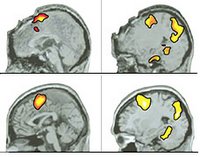Seriously Creepy Research: The Neurology of the Feeling That Someone's Watching You
 Here's some crazy brain research for you: Most people, at some point or another, have had that creepy feeling that somebody's nearby. That they're being watched. Well, a group of scientists just figured out that they can stimulate that disturbing feeling by applying electric stimulation to a specific area in a patient's brain. But they didn't do it on purpose:
Here's some crazy brain research for you: Most people, at some point or another, have had that creepy feeling that somebody's nearby. That they're being watched. Well, a group of scientists just figured out that they can stimulate that disturbing feeling by applying electric stimulation to a specific area in a patient's brain. But they didn't do it on purpose:"Doctors unintentionally produced the delusion while evaluating a 22-year-old epileptic woman for possible surgery. Though the woman had no history of psychological problems, she repeatedly perceived a "shadow person" hovering behind her when doctors electrically stimulated an area of her brain called the left temporoparietal junction. "Our data most importantly show that paranoia might be related to disturbed processing of one's own body, [which] in some instances may become misrecognized as the body of somebody else," said Olaf Blanke, a neuroscientist at the Swiss Federal Institute of Technology in Lausanne. The hallucinatory condition was temporary and ended when stimulations were stopped.The photo above is a computerized drawing -- she shadow behind the woman illustrates where she felt this man (and interesting that it was a man, not a woman). What's perhaps most creepy is, the patient -- who had no history of delusions -- thought this was real. She had no idea she was experiencing some kind of hallucination. The researchers think the electronic stimulation temporarily confused her brain's ability to comprehend its own body. Which could make sense, since the part of the brain they zapped is connected to self-perception, distinguishing self from non-self, and understanding where your body is in space.
"During her ordeal, the patient described sensing an unknown person standing just behind her, mimicking her body positions. "He is behind me, almost at my body, but I do not feel it," she told doctors, who report their discovery in this week's issue of the journal Nature. When asked to lean forward and grasp her knees, the patient reported that she felt as if the shadow person were embracing herÂa sensation she described as disturbing. When performing assigned activities, such as a language-testing card game, she said that the shadow tried to interfere. "He wants to take the card," she told doctors. "He doesn't want me to read."
Of course, this doesn't actually tell us much in the end, since it only happened to one patient, but it's totally fascinating. Perhaps someday it will lead to a larger study that looks at this phenomena ... Finding volunteers for that one might be tricky though. I sure wouldn't do it. Tooooo creepy.
Labels: Neuro, Weird Science









